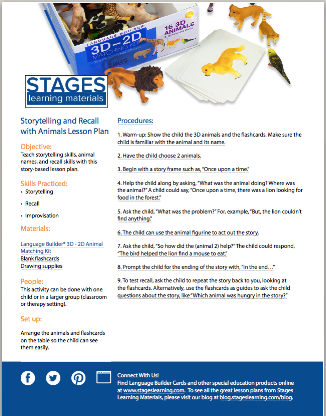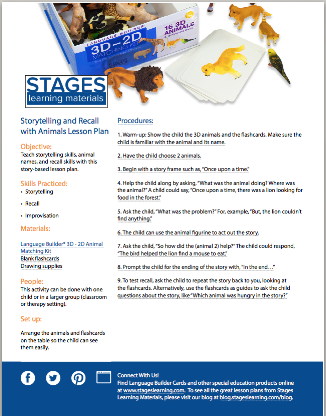Storytelling and Recall with Animals Lesson Plan
Lesson Overview
Teach storytelling skills, animal names, and recall skills with this story-based lesson plan.
Skills Practiced
- Storytelling
- Recall
- Improvisation
Materials
- Drawing supplies (Optional)
People
This activity can be done with just one child or in a larger group, in a classroom or therapy setting. Children should be familiar with basic elements of a story and with animal names.
Set-up
Arrange the animals and flashcards on the table so the child can see them easily.
Procedures
- Warm-up: Show the child the 3D animals and make sure the child is familiar with the animal and its name. Then, repeat the same with the animal flashcards.
- Have the child choose 2 animals that are his/her favorite. Let the child know that you will be telling a story about the 2 animals together.
- Begin with a story frame such as, “Once upon a time,” or “One day…”
- Help the child along by asking, “What was the animal doing? Where was the animal?” For example, a child could say, “Once upon a time, there was a lion looking for food in the forest.”
- Then ask the child, “What was the problem?” You can prompt the child with the word, “But…” For example, “But, the lion couldn’t find anything.”
- The child can use the animal figurine to act out the story.
- Next, ask the child, “So how did the (animal 2) help?” For example, “So how did the bird help?” The child could respond, “The bird helped the lion find a mouse to eat.”
- Then, prompt the child for the ending of the story with, “In the end…” For example, “In the end, the lion wasn’t hungry anymore and they became friends.”
- Feel free to help/prompt as little or as much as developmentally necessary.
- Then, to test recall, ask the child to repeat the story back to you, looking only at the flashcards. Alternatively, you can use the flashcards as guides to ask the child questions about the story. For example, “Which animal was hungry in the story?” or “Which animal saved the day?”
Variations
- For a more difficult version of the exercise, see if the child can tell a story using more than 2 animals. For a child who finds a complete story too difficult, you can tell the entire story using the animals, and ask the child just to recall the story.
- On blank flashcards, either you or the child can draw very simple sketches to illustrate the verbal story. During the recall activity, ask the child to use the flashcards to help recall the story.







